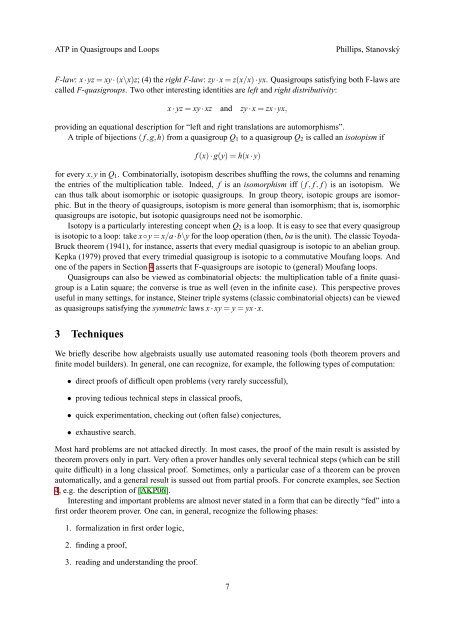Automated Theorem Proving in Quasigroup and Loop Theory
Automated Theorem Proving in Quasigroup and Loop Theory
Automated Theorem Proving in Quasigroup and Loop Theory
You also want an ePaper? Increase the reach of your titles
YUMPU automatically turns print PDFs into web optimized ePapers that Google loves.
ATP <strong>in</strong> <strong>Quasigroup</strong>s <strong>and</strong> <strong>Loop</strong>s<br />
Phillips, Stanovský<br />
F-law: x ·yz = xy·(x\x)z; (4) the right F-law: zy·x = z(x/x)·yx. <strong>Quasigroup</strong>s satisfy<strong>in</strong>g both F-laws are<br />
called F-quasigroups. Two other <strong>in</strong>terest<strong>in</strong>g identities are left <strong>and</strong> right distributivity:<br />
x · yz = xy · xz <strong>and</strong> zy · x = zx · yx,<br />
provid<strong>in</strong>g an equational description for “left <strong>and</strong> right translations are automorphisms”.<br />
A triple of bijections ( f ,g,h) from a quasigroup Q 1 to a quasigroup Q 2 is called an isotopism if<br />
f (x) · g(y) = h(x · y)<br />
for every x,y <strong>in</strong> Q 1 . Comb<strong>in</strong>atorially, isotopism describes shuffl<strong>in</strong>g the rows, the columns <strong>and</strong> renam<strong>in</strong>g<br />
the entries of the multiplication table. Indeed, f is an isomorphism iff ( f , f , f ) is an isotopism. We<br />
can thus talk about isomorphic or isotopic quasigroups. In group theory, isotopic groups are isomorphic.<br />
But <strong>in</strong> the theory of quasigroups, isotopism is more general than isomorphism; that is, isomorphic<br />
quasigroups are isotopic, but isotopic quasigroups need not be isomorphic.<br />
Isotopy is a particularly <strong>in</strong>terest<strong>in</strong>g concept when Q 2 is a loop. It is easy to see that every quasigroup<br />
is isotopic to a loop: take x◦y = x/a·b\y for the loop operation (then, ba is the unit). The classic Toyoda-<br />
Bruck theorem (1941), for <strong>in</strong>stance, asserts that every medial quasigroup is isotopic to an abelian group.<br />
Kepka (1979) proved that every trimedial quasigroup is isotopic to a commutative Moufang loops. And<br />
one of the papers <strong>in</strong> Section 4 asserts that F-quasigroups are isotopic to (general) Moufang loops.<br />
<strong>Quasigroup</strong>s can also be viewed as comb<strong>in</strong>atorial objects: the multiplication table of a f<strong>in</strong>ite quasigroup<br />
is a Lat<strong>in</strong> square; the converse is true as well (even <strong>in</strong> the <strong>in</strong>f<strong>in</strong>ite case). This perspective proves<br />
useful <strong>in</strong> many sett<strong>in</strong>gs, for <strong>in</strong>stance, Ste<strong>in</strong>er triple systems (classic comb<strong>in</strong>atorial objects) can be viewed<br />
as quasigroups satisfy<strong>in</strong>g the symmetric laws x · xy = y = yx · x.<br />
3 Techniques<br />
We briefly describe how algebraists usually use automated reason<strong>in</strong>g tools (both theorem provers <strong>and</strong><br />
f<strong>in</strong>ite model builders). In general, one can recognize, for example, the follow<strong>in</strong>g types of computation:<br />
• direct proofs of difficult open problems (very rarely successful),<br />
• prov<strong>in</strong>g tedious technical steps <strong>in</strong> classical proofs,<br />
• quick experimentation, check<strong>in</strong>g out (often false) conjectures,<br />
• exhaustive search.<br />
Most hard problems are not attacked directly. In most cases, the proof of the ma<strong>in</strong> result is assisted by<br />
theorem provers only <strong>in</strong> part. Very often a prover h<strong>and</strong>les only several technical steps (which can be still<br />
quite difficult) <strong>in</strong> a long classical proof. Sometimes, only a particular case of a theorem can be proven<br />
automatically, <strong>and</strong> a general result is sussed out from partial proofs. For concrete examples, see Section<br />
4, e.g. the description of [AKP06].<br />
Interest<strong>in</strong>g <strong>and</strong> important problems are almost never stated <strong>in</strong> a form that can be directly “fed” <strong>in</strong>to a<br />
first order theorem prover. One can, <strong>in</strong> general, recognize the follow<strong>in</strong>g phases:<br />
1. formalization <strong>in</strong> first order logic,<br />
2. f<strong>in</strong>d<strong>in</strong>g a proof,<br />
3. read<strong>in</strong>g <strong>and</strong> underst<strong>and</strong><strong>in</strong>g the proof.<br />
7
















